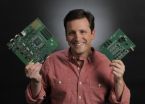(Press-News.org) Toronto, ON (27 November, 2012) -- A new method of growing cardiac tissue is teaching old stem cells new tricks. The discovery, which transforms aged stem cells into cells that function like much younger ones, may one day enable scientists to grow cardiac patches for damaged or diseased hearts from a patient's own stem cells—no matter what age the patient—while avoiding the threat of rejection.
Stem cell therapies involving donated bone marrow stem cells run the risk of patient rejection in a portion of the population, argues Milica Radisic, Canada Research Chair in Functional Cardiovascular Tissue Engineering at the Institute of Biomaterials and Biomedical Engineering (IBBME) and Associate Professor in the Department of Chemical Engineering and Applied Chemistry at the University of Toronto.
One method of avoiding the risk of rejection has been to use cells derived from a patient's own body. But until now, clinical trials of this kind of therapy using elderly patients' own cells have not been a viable option, since aged cells tend not to function as well as cells from young patients.
"If you want to treat these people with their own cells, how do you do this?"
It's a problem that Radisic and her co-researcher, Dr. Ren-Ke Li, think they might have an answer for: by creating the conditions for a 'fountain of youth' reaction within a tissue culture.
Li holds the Canada Research Chair in Cardiac Regeneration and is a Professor in the Division of Cardiovascular Surgery, cross-appointed to IBBME. He is also a Senior Scientist at the Toronto General Research Institute.
Radisic and Li first create a "micro-environment" that allows heart tissue to grow, with stem cells donated from elderly patients at the Toronto General Hospital.
The cell cultures are then infused with a combination of growth factors—common factors that cause blood vessel growth and cell proliferation—positioned in such a way within the porous scaffolding that the cells are able to be stimulated by these factors.
Dr. Li and his team then tracked the molecular changes in the tissue patch cells.
"We saw certain aging factors turned off," states Li, citing the levels of two molecules in particular, p16 and RGN, which effectively turned back the clock in the cells, returning them to robust and healthy states.
"It's very exciting research," says Radisic, who was named one of the top innovators under 35 by MIT in 2008 and winner of the 2012 Young Engineers Canada award.
Li and Radisic hope to continue their goal to create the most effective environment in which cells from older patients can be given new life. "We can create much better tissues which can then be used to repair defects such as aneurysms," Li says, as well as repairing damage caused by heart attacks.
The study was recently released in the Journal of the American College of Cardiology, the top journal in the field of cardiovascular medicine.
INFORMATION:
About IBBME
The Institute of Biomaterials and Biomedical Engineering (IBBME) is an interdisciplinary unit situated between three Faculties at the University of Toronto: Applied Science and Engineering, Dentistry and Medicine. The Institute pursues research in four areas: neural, sensory systems and rehabilitation engineering; biomaterials, tissue engineering and regenerative medicine; molecular imaging and biomedical nanotechnology; medical devices and clinical technologies.
'Fountain of youth' technique rejuvenates aging stem cells
Study moves scientists 1 step closer to creating youthful heart patches from old cells
2012-11-28
ELSE PRESS RELEASES FROM THIS DATE:
How vegetables make the meal
2012-11-28
Parents may have some new motivations to serve their kids vegetables. A new Cornell University study, published in Public Health Nutrition, found that by simply serving vegetables with dinner, the main course would taste better and the preparer was perceived to be more thoughtful and attentive.
"Most parents know that vegetables are healthy, yet vegetables are served at only 23% of American dinners," said lead author Brian Wansink, PhD, the John Dyson Professor of Marketing and Consumer Behavior at Cornell University. "If parents knew that adding vegetables to the plate ...
GSA Bulletin: From Titan to Tibet
2012-11-28
Boulder, Colo., USA – GSA Bulletin articles posted online between 2 October and 21 November span locations such as the San Andreas fault, California; Tibet; Mongolia; Maine; the Owyhee River, Oregon; the Afar Rift, Ethiopia; Wyoming; Argentina; the Sinai Peninsula, Egypt; British Columbia; the southern Rocky Mountains; Scandinavia; and Saturn's largest moon, Titan. Topics include the "big crisis" in the history of life on Earth; the structural geology of Mount St. Helens; and the evolution of a piggyback basin.
GSA Bulletin articles published ahead of print are online ...
NASA's TRMM satellite confirms 2010 landslides
2012-11-28
A NASA study using TRMM satellite data revealed that the year 2010 was a particularly bad year for landslides around the world.
A recent NASA study published in the October issue of the Journal of Hydrometeorology compared satellite rain data from NASA's Tropical Rainfall Measurement Mission (TRMM) to landslides in central eastern China, Central America and the Himalayan Arc, three regions with diverse climates and topography where rainfall-triggered landslides are frequent and destructive hazards to the local populations.
The work, led by Dalia Kirschbaum, a research ...
Fast forward to the past: NASA technologists test 'game-changing' data-processing technology
2012-11-28
It's a digital world. Or is it?
NASA technologist Jonathan Pellish isn't convinced. In fact, he believes a computing technology of yesteryear could potentially revolutionize everything from autonomous rendezvous and docking to remotely correcting wavefront errors on large, deployable space telescope mirrors like those to fly on the James Webb Space Telescope.
"It's fast forward to the past," Pellish said, referring to an emerging processing technology developed by a Cambridge, Mass.-based company, Analog Devices Lyric Labs.
So convinced is he of its potential, Pellish ...
NASA sees Tropical Storm Bopha intensifying in Micronesia
2012-11-28
Tropical storm warnings are in effect in Micronesia as NASA and other satellite imagery indicates that Tropical Storm Bopha continues to intensify.
The Atmospheric Infrared Sounder (AIRS) instrument that flies aboard NASA's Aqua satellite captured an infrared image of Tropical Storm Bopha on Nov. 27 at 0241 UTC that indicated a lot of power exists in the strengthening tropical storm. The AIRS image captured the eastern half of the tropical storm and showed a large area of very cold, very high cloud tops, where temperatures colder than -63 Fahrenheit (-52 Celsius) have ...
High altitude climbers at risk for brain bleeds
2012-11-28
CHICAGO – New magnetic resonance imaging (MRI) research shows that mountain climbers who experience a certain type of high altitude sickness have traces of bleeding in the brain years after the initial incident, according to a study presented today at the annual meeting of the Radiological Society of North America (RSNA).
High altitude cerebral edema (HACE) is a severe and often fatal condition that can affect mountain climbers, hikers, skiers and travelers at high altitudes—typically above 7,000 feet, or 2,300 meters.
HACE results from swelling of brain tissue due ...
Most patients in the dark about what radiologists do
2012-11-28
CHICAGO – The role of radiologists in healthcare has long been poorly understood among the general public, but new research presented today at the annual meeting of the Radiological Society of North America (RSNA) shows that even patients who've had imaging exams in the past know little about the profession.
Researchers said the study findings highlight an opportunity for radiologists to educate the public about their role in healthcare.
"We know from previous studies that about half of the general public doesn't even know that radiologists are physicians," said Peter ...
Men with belly fat at risk for osteoporosis
2012-11-28
CHICAGO – Visceral, or deep belly, obesity is a risk factor for bone loss and decreased bone strength in men, according to a study presented today at the annual meeting of the Radiological Society of North America (RSNA).
"It is important for men to be aware that excess belly fat is not only a risk factor for heart disease and diabetes, it is also a risk factor for bone loss," said Miriam Bredella, M.D., radiologist at Massachusetts General Hospital and associate professor of radiology at Harvard Medical School in Boston.
According to the National Center for Health ...
CT depicts racial differences in coronary artery disease
2012-11-28
CHICAGO – While obesity is considered a cardiovascular risk factor, a study presented today at the annual meeting of the Radiological Society of North America (RSNA) showed that African-American patients with coronary artery disease (CAD) have much less fat around their hearts compared to Caucasian patients.
"Prior evidence suggests that increased fat around the heart may be either an independent marker of CAD burden or a predictor of the future risk of acute coronary events," said U. Joseph Schoepf, M.D., professor of radiology and medicine and director of cardiovascular ...
New study: Many flame retardants in house dust -- unsafe levels
2012-11-28
A peer-reviewed study of the largest number of flame retardants ever tested in homes found that most houses had levels of at least one flame retardant that exceeded a federal health guideline. The journal Environmental Science & Technology will publish the study online on November 28, 12:01am Eastern.
The study led by scientists at Silent Spring Institute tested for 49 flame retardant chemicals in household dust, the main route of exposure for people and especially for children. Forty-four flame retardant chemicals were detected and 36 were found in at least 50% of the ...
LAST 30 PRESS RELEASES:
Injectable breast ‘implant’ offers alternative to traditional surgeries
Neuroscientists devise formulas to measure multilingualism
New prostate cancer trial seeks to reduce toxicity without sacrificing efficacy
Geometry shapes life
A CRISPR screen reveals many previously unrecognized genes required for brain development and a new neurodevelopmental disorder
Hot flush treatment has anti-breast cancer activity, study finds
Securing AI systems against growing cybersecurity threats
Longest observation of an active solar region
Why nail-biting, procrastination and other self-sabotaging behaviors are rooted in survival instincts
Regional variations in mechanical properties of porcine leptomeninges
Artificial empathy in therapy and healthcare: advancements in interpersonal interaction technologies
Why some brains switch gears more efficiently than others
UVA’s Jundong Li wins ICDM’S 2025 Tao Li Award for data mining, machine learning
UVA’s low-power, high-performance computer power player Mircea Stan earns National Academy of Inventors fellowship
Not playing by the rules: USU researcher explores filamentous algae dynamics in rivers
Do our body clocks influence our risk of dementia?
Anthropologists offer new evidence of bipedalism in long-debated fossil discovery
Safer receipt paper from wood
Dosage-sensitive genes suggest no whole-genome duplications in ancestral angiosperm
First ancient human herpesvirus genomes document their deep history with humans
Why Some Bacteria Survive Antibiotics and How to Stop Them - New study reveals that bacteria can survive antibiotic treatment through two fundamentally different “shutdown modes”
UCLA study links scar healing to dangerous placenta condition
CHANGE-seq-BE finds off-target changes in the genome from base editors
The Journal of Nuclear Medicine Ahead-of-Print Tip Sheet: January 2, 2026
Delayed or absent first dose of measles, mumps, and rubella vaccination
Trends in US preterm birth rates by household income and race and ethnicity
Study identifies potential biomarker linked to progression and brain inflammation in multiple sclerosis
Many mothers in Norway do not show up for postnatal check-ups
Researchers want to find out why quick clay is so unstable
Superradiant spins show teamwork at the quantum scale
[Press-News.org] 'Fountain of youth' technique rejuvenates aging stem cellsStudy moves scientists 1 step closer to creating youthful heart patches from old cells





